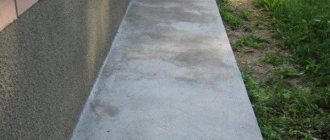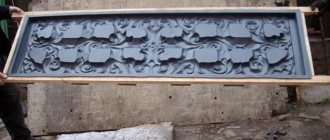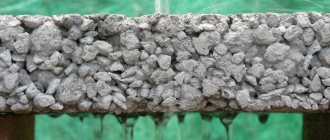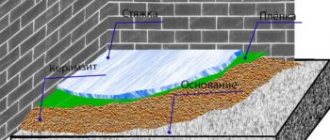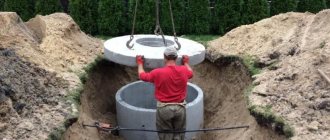Beton-House.com
Website about concrete: construction, characteristics, design. We combine the experience of professionals and private craftsmen in one place
Molds and products made using them
Among the structural elements of buildings and landscape design elements, concrete products are the most common. These are wall blocks, columns, tiles, small architectural forms, and much more. They are made by pouring concrete into molds. And they do this not only in industrial settings.
Plastic molds for concrete products allow you to set up your own mini-production or cast piece products for personal use.
Today on sale you can find different versions of such forms, differing both in shape and size, and in the material from which they are made. Plastic products are perhaps the most popular. Let's talk about their features and selection criteria.
- Technical requirements
Cast concrete
Cast concrete was developed and introduced into the construction industry at the end of the 20th century.
Cast concrete
Its main purpose is finishing of horizontal surfaces. With its use, concrete casting no longer requires labor-intensive vibration compaction, and high-quality surfaces became accessible to a basic craftsman without complex and bulky tools.
Required proportions
The strength of the structure will depend on the ratio of sand and cement for paving slabs you use.
- The optimal ratio of sand to cement will be one to one.
- Crushed stone must be taken so that its mass exceeds the mass of the cement used by approximately six times.
- We add plasticizer in small quantities, about half a percent of the amount of cement.
- The volume of water in the mixture should be equal to 40% of the total volume of the remaining components.
Cement mortar for paving slabs Source 1beton.info
Advantages and disadvantages of poured concrete
The main advantage of cast concrete is its plasticity. This makes it easier to pour and there is no need to resort to vibration compaction, as is required when pouring conventional concrete.
Basic characteristics of plasticity
The composition of cast concrete also includes additives that retain moisture in the material. This increases the time available for surface adjustment and increases the spreadability of the composition.
Cast concrete is also resistant to moisture penetration, can remain in contact with the ground for a long time and can withstand contact with water for a certain time. Polymer additives make the material insensitive to temperature changes.
Plasticity of cast concrete
The main and, perhaps, the only disadvantage of cast concrete is its high cost due to the high price of polymer additives, which make up up to one twentieth of the total volume.
Application, main characteristics and functions of the components of the concrete mixture
Due to its plasticity, artistic concrete has a very wide range of applications. Concrete figures of any size, stucco molding, garden vases and flowerpots, decorative stone, small architectural forms and much more are made from it.
Depending on the task, the composition of the concrete mixture changes due to the qualitative and quantitative inclusion of various polymer, chemical and mineral additives.
Their function is to impart plasticity to the concrete mixture, the ability to regulate fluidity, hardening time, and increase water resistance and frost resistance.
To strengthen the structure of the stone, active substances are introduced into the mixture: microsilica and various ash. To obtain a more mobile solution, plasticizers are used for better mixing, as well as to reduce the amount of mixing water. For self-compacting concrete (no vibration required), hyperplasticizers are used, with which it is possible to obtain thin and especially strong structures. Fine-grained cement is also used for these purposes. The larger the number in its name, the smaller the cement grain and the higher the strength of the product can be obtained (with the same amount of cement).
Artistic concrete can be colored by introducing colored pigments into the solution. Mineral pigments (oxides and salts of various metals) are most often used. Organic pigments and aniline dyes can also be introduced. The latter give a more intense color with less quantity. But they are less resistant to the destructive effects of ultraviolet radiation. When using the latter, it is more difficult to obtain a uniform color of the product without including special additives in the mixture (for example, white soot).
Dyes somewhat reduce the strength of the product, as they require an increase in the amount of mixing water. Therefore, the internal color must be limited by introducing a minimum amount of dye, and a more saturated color can be obtained through additional external coloring. More details about methods of coloring artificial stone are described in the corresponding article on this topic.
Method of casting concrete for the manufacture of concrete products
Casting concrete products into matrices in single copies or small runs does not require complex equipment. In this case, you can get by with manual mixing and manual compaction of the solution.
If you plan to cast concrete into molds in medium quantities, it is better to get a concrete mixer and a vibrating compactor.
Making concrete castings at home is a simple process. However, the master should pay attention to a number of subtleties.
If it is necessary to cast large products, such as curbs, posts or piles, it is better to make the formwork from wood or OSB. When casting products with a side measuring more than half a meter, additional stiffening elements will be required so that the formwork does not burst during pouring. The formwork should be made collapsible and should be thoroughly wetted before pouring the solution. This will make it easy to remove the formwork after the casting has hardened, preventing the concrete from sticking to the form. A mold made of OSB, plywood or metal is lubricated with machine oil for the same purpose.
If wood is not available, then, as a last resort, the casting matrix can be dug into the ground. You need to pour sand into the dug hole, moisten it well and pour the solution. Of course, the dimensional accuracy and surface quality in the case of casting into the ground will be more than modest.
What else to pay attention to
Of course, the most basic selection criteria are the quality and cost of the products. High quality can only be achieved by manufacturing molds and good raw materials using modern technologies.
What are the requirements for these products? They can be divided into technical, decorative-aesthetic and economic.
Technical requirements
These include:
- Light weight . Unlike metal or wood, all plastic forms have this advantage.
- Low adhesion to concrete. In order not to rack your brains about how to clean plastic molds from concrete or what to lubricate them with before pouring the solution, you need to choose products that do not “stick” to it.
Cleaning molds from solution
Advice. Manufacturers usually recommend products for lubricating and cleaning plastic molds. But the drugs are not cheap and increase the cost of finished products. Therefore, instead of a special lubricant, you can use sunflower oil or a soap solution, and clean it with ordinary water immediately after stripping. If time is lost and the solution has dried out, before cleaning plastic forms from concrete with proprietary products, try using a 5% solution of hydrochloric acid or a 35% solution of acetic acid.
Lubricant is applied with a brush or spray
- Ease of unmolding . Products must be removed from the mold without vibration or steaming.
Finished products should be easy to remove from the mold
Decorative and aesthetic requirements
The shapes must have clear edges so that the quality of the geometric parameters of the finished products is at their best.
It is worth paying attention to the quality of texture transfer. In this regard, soft and elastic forms are preferable to rigid or semi-rigid ones, but are inferior to them in maintaining geometric parameters.
Removing the flexible mold
It is also better to give preference to products with low abrasive wear, due to which finished products will lose their attractive appearance over time.
Economic requirements
The cost of plastic molds is a relative concept. When purchasing them, you need to take into account another parameter - the cost of one removal. What does this mean?
The operating instructions for any injection mold take into account their service life or the number of removals - cycles of pouring and unmolding while maintaining the operational characteristics of the product.
The number of products made with its help depends on the service life of the mold.
For example, the service life of PVC molds does not exceed 50 cycles. At a cost of 900 rubles, the price of one rental will be 18 rubles.
At the same time, the service life of ABS plastic molds is about 300 cycles. Despite the fact that they can cost twice as much, each meal will cost much less - from 5-6 rubles.
Note. This parameter is important only in the case of constant and regular use of matrices. For example, when organizing the production of concrete products for sale. If you need to make a limited number of elements for personal needs, without using the entire resource of plastic molds, look at their cost.
DIY forms
Homemade forms for garden paths can be made from wood, metal, plastic or polyurethane. Let's consider the simplest option - wooden molds for pouring. Wooden molds for tiles are divided into:
- into square matrices;
- rectangular options;
- hexagons - reminiscent of a honeycomb. This filling option looks original and unobtrusive.
How to make square shapes
- To make a square matrix, use 5x5 bars. The bars form the formwork - the frame of our form.
- The bars are secured together with wood screws.
- To make the structure rigid, metal corners are attached. Now the matrix can be used many times.
- Options with a bottom are preferable. Use laminated plywood, which must be screwed to the frame.
You can make a mold without a bottom, but then you need to fill it locally. This is not always convenient: it may rain unexpectedly outside. The solution must be protected from direct sunlight, otherwise the moisture will quickly evaporate and there will be cracks in the finished fragment.
Use of wooden matrices
- Pour the prepared solution into them. To increase strength, throw pieces of reinforcement or wire into the solution.
- To make a design on the front side, place a piece of tile or stone on the bottom of the mold. When the solution hardens and you remove the tile, there will be additional decor on the front side.
- Drying is not carried out in the open sun. Place the molds in the shade to air or in a ventilated area.
Laying tiles
The finished tiles can be laid on sand with dry cement, or on concrete mortar. For a path for which heavy loads are not expected, the first option is suitable. The second option is necessary if there is a heavy load on the path, for example, a car moving along it.
First of all, you need to prepare the site. A pit is dug about ten centimeters deep, and fine granite is poured into it to the middle of the depth. Granite is carefully compacted. A sand-cement mortar is poured on top of it. Sand and cement in such a solution are mixed in a ratio of four to one, and water is added in a volume equal to the volume of cement.
Tiles are laid on the poured path. The pouring and laying procedure should be carried out over small areas, approximately one square meter. This is necessary to achieve uniform laying.
Laying tiles Source ibuildrussia.ru
Features of choosing material for the production of garden decorations
Figures for the garden can be cast from plaster, concrete and polystone. Products made from gypsum sell out faster. They have the lowest price. Therefore, organizing the production of such products is a very simple process that does not require large material investments. A kilogram of gypsum costs from 40 rubles. It produces very fragile products that are not resistant to any mechanical loads. They absorb moisture. The service life of such a garden decoration is one season, but consumer demand for such products is still quite high, so you can safely work in the designated direction.
Garden figurines made of plaster Source svarka-doka.ru
